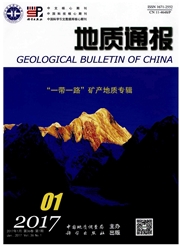

 中文摘要:
中文摘要:
早白垩世酒泉盆地是1个由断陷盆地和坳陷盆地叠置的复合盆地,主要经历了早白垩世断陷和新生代前陆盆地2个演化阶段。早白垩世时期,受西伯利亚板块、太平洋板块和印度板块的共同作用,以及深部热事件的影响,酒西地区处于松弛拉张裂陷阶段,从早到晚发育完整的下白垩统赤金桥组-赤金堡组-下沟组-中沟组,地层厚度总体为西南厚、北部薄。下白垩统的沉积岩相分析表明,下沟组和中沟组岩性以山前粗碎屑岩、河流相砂岩和湖泊相泥岩为主,自下而上分别由粗-细-粗和粗-细的沉积序列组成。下沟组辫状河三角洲-湖泊沉积体系及基性火山岩均形成于湖盆裂陷最大的时期;中沟组为冲积扇-曲流河沉积体系,为盆地坳陷萎缩期的产物。酒泉盆地早白垩世水体西南部深、北部浅,沉积、沉降中心位于昌马-旱峡一带,以湖相沉积为主。新民堡、红柳峡地区则属于湖盆北部边缘,以三角洲-滨浅湖沉积为主。酒西地区早白垩世沉积序列和沉积相时空发育的特征显现了盆地从初始断陷(赤金桥组、赤金堡纽)、中期扩张发展(下沟纽)至最终坳陷萎缩(中沟纽)的演化过程。
 英文摘要:
英文摘要:
Jiuquan Basin is a composite basin which experienced rifting and depression stages in the Early Cretaceous. The basin experienced the evolution phases of rifted basin in the Early Cretaceous and foreland basin in the Cenozoic. Affected by the joint action of Siberia plate, Pacific plate and India plate as well as the thermal event in depth, Jiuxi area was in an extensional rifting phase during the Early Cretaceous. The sediments can be divided in upward succession into Chijinqiao Formation, Chijinpu Formation, Xiagou Formation and Zhonggou Formation. The strata are thick in the southwest and thin in the north. Studies of the sedimentary facies show that the Xiagon and Zhonggou Formations were mainly characterized by the coarse clastic rock in foreland of mountain, fluvial sandstone and lacustrine mudstone, and coarse-fine-coarse and coarse-fine sedimentary successions comprised the Xiagou Formation and the Zhonggou Formation respectively. The Xiagou Formation developed lacustrine-braided fluvial delta facies and basic volcanic rocks, corresponding to the maximum rifting degree, whereas the Zhonggou Formation developed fluvial fan-meandering river facies, corre- sponding to the shrinkage of the depression. Studies show that the lake was deep in southwest Jiuquan basin while shallow in northern Jiuquan basin in the Early Cretaceous. The center of subsidence and depocenter were located in the Changma-Hanxia area, dominated by lacnstrine deposits; the north border was in Xinminpu-Hongliuxia area, dominated by delta-shallow lake deposits. In a word, the characteristics of sedimentary successions and sedimentary environments of the lower Cretaceous strata in Jiuxi area indicate a complete tectonic cycle starting with embryonic rifting stage (Chijinqiao Formation and Chijinpu Formation), followed then by extensional rifting stage (Xiagou Formation) and finally by depression shrinkage stage (Zhonggou Formation).
 同期刊论文项目
同期刊论文项目
 同项目期刊论文
同项目期刊论文
 A New Rhamphorhynchid Pterosaur (Pterosauria) from the Middle Jurassic Tiaojishan Formation of Weste
A New Rhamphorhynchid Pterosaur (Pterosauria) from the Middle Jurassic Tiaojishan Formation of Weste Timing of the earliest known feathered dinosaurs and transitional pterosaurs older than the Jehol Bi
Timing of the earliest known feathered dinosaurs and transitional pterosaurs older than the Jehol Bi A new troodontid theropod from the Late Cretaceous of central China, and the radiation of Asian troo
A new troodontid theropod from the Late Cretaceous of central China, and the radiation of Asian troo A New Darwinopterid Pterosaur from the Middle Jurassic of Western Liaoning, Northeastern China and i
A New Darwinopterid Pterosaur from the Middle Jurassic of Western Liaoning, Northeastern China and i An Unusual Basal Therizinosaur Dinosaur with an Ornithischian Dental Arrangement from Northeastern C
An Unusual Basal Therizinosaur Dinosaur with an Ornithischian Dental Arrangement from Northeastern C A new sauropod dinosaur (Dinosauria, Sauropoda) from the late Early Cretaceous of the Ruyang Basin (
A new sauropod dinosaur (Dinosauria, Sauropoda) from the late Early Cretaceous of the Ruyang Basin ( Dinosaur-bearing strata and K/T boundary in the Luanchuan-Tantou Basin of western Henan Province, Ch
Dinosaur-bearing strata and K/T boundary in the Luanchuan-Tantou Basin of western Henan Province, Ch 期刊信息
期刊信息
